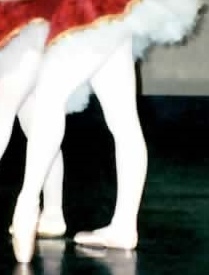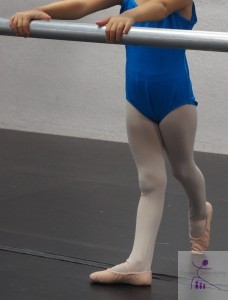I came home from teaching last week with a lot on my mind. After a lot of pondering, I had an “ah-ha” moment about what was bothering me: I teach ballet the same way I feel about toddler art. It’s about the Process, not the Product.
One of my biggest pet peeves when I’m in a childcare center/preschool is when an entire class’s art projects all look the same. You know, 15 pumpkins with perfectly placed eyes, noses and mouths outside a 2 year old classroom or 10 flowers with the petals all placed exactly around the border with rounded edges out in a 1 year old classroom. This is a dead giveaway that the students were given a model to follow as well as extensive adult guidance and help.
Art (for all ages, really) should be about the process: what skills did the child learn, develop or practice? What was the child’s intention, if any, behind their choices? It’s not about whether the product of their “butterfly” project actually looks like a butterfly or not.
 One of my favorite bulletin boards I ever made as a early childhood teacher was an “under the sea” themed board in which the children made lobsters, fish and starfish while we read books about sea animals. They drew “coral reefs” with red crayons then painted over with blue water colors. then they painted goldfish (which were cut and assembled BEFORE they painted) and they covered seastars with sand.
One of my favorite bulletin boards I ever made as a early childhood teacher was an “under the sea” themed board in which the children made lobsters, fish and starfish while we read books about sea animals. They drew “coral reefs” with red crayons then painted over with blue water colors. then they painted goldfish (which were cut and assembled BEFORE they painted) and they covered seastars with sand.
For the lobsters I cut a pink egg carton into two bump sections and also cut out two claws and one tail for each child. The children were then given a piece of blue paper with glue spread all over and asked to “make a lobster” with their egg carton body, claws and tails. I did not expect them to get everything lined up properly and was delighted by the abstract lobster creations they came up with.
Likewise, when I teach dance, I worry about the process of HOW my students are moving their bodies not just the product of what the pictures they make look like. I want my students to learn how to move in a physiologically correct, safe and efficient way. I don’t want them to achieve a desirable skill (like higher extensions, bigger jumps or more turns) if they have to sacrifice the safety and stability of their movement to do so.
Injury is considered just part of being a dancer but it shouldn’t be. I can speak from experience, I suffered 3 injuries during my dancing days that were severe enough to prevent me from dancing fully. The first was an accidental fall down the middle school stairs resulting in a sprained ankle. The second was an overuse injury (tendinitis in my ankles) my junior year of High School which continued to plague me through college.
 The third was severe knee pain which took me to a PT and forced me to change the way I danced. I always had hyper-extended (or “locked” knees that curved backwards when straightened as in photo). While this is a desirable “look” to have as a ballerina, it is not functional. It causes the dancer to not properly use her leg muscles to hold her body up, instead relying on the bone-to-bone position of her knee joint. In my dancing, this “locking back” cause the front of my knees around the patella to ache constantly and the only way to relieve the pain was to retrain my body to use my muscles to stand up. It sounds silly but after so many years of relying on my locked joint for stability learning to use my muscles was a huge struggle. I had very little strength in my legs and went through many frustrating months basically relearning how to dance. It was all worth it, though, as now I can’t hyper-extend my knees if I wanted to and the pain subsided almost instantly once I started using my muscles correctly.
The third was severe knee pain which took me to a PT and forced me to change the way I danced. I always had hyper-extended (or “locked” knees that curved backwards when straightened as in photo). While this is a desirable “look” to have as a ballerina, it is not functional. It causes the dancer to not properly use her leg muscles to hold her body up, instead relying on the bone-to-bone position of her knee joint. In my dancing, this “locking back” cause the front of my knees around the patella to ache constantly and the only way to relieve the pain was to retrain my body to use my muscles to stand up. It sounds silly but after so many years of relying on my locked joint for stability learning to use my muscles was a huge struggle. I had very little strength in my legs and went through many frustrating months basically relearning how to dance. It was all worth it, though, as now I can’t hyper-extend my knees if I wanted to and the pain subsided almost instantly once I started using my muscles correctly.
The thing about injuries in dance is they aren’t taken seriously. Since it’s considered “part of the game,” most people don’t worry about preventing injuries in the first place. Like anything else, dancers assume injuries won’t happen to them and so they’re just dealt with if and when they happen. Most big companies are starting to focus on injury prevention and have specialists on staff but unfortunately it’s yet to trickle down to most independent studios.
 And now I have an even bigger stake in the whole thing: I have my own little dancer with hyper-extended knees. And she’s started complaining about knee pain. I can easily look at things objectively and do what little bit I can to fix the problem but when the problem starts affecting MY (very young) child, it’s much harder for me to wait it out.
And now I have an even bigger stake in the whole thing: I have my own little dancer with hyper-extended knees. And she’s started complaining about knee pain. I can easily look at things objectively and do what little bit I can to fix the problem but when the problem starts affecting MY (very young) child, it’s much harder for me to wait it out.




